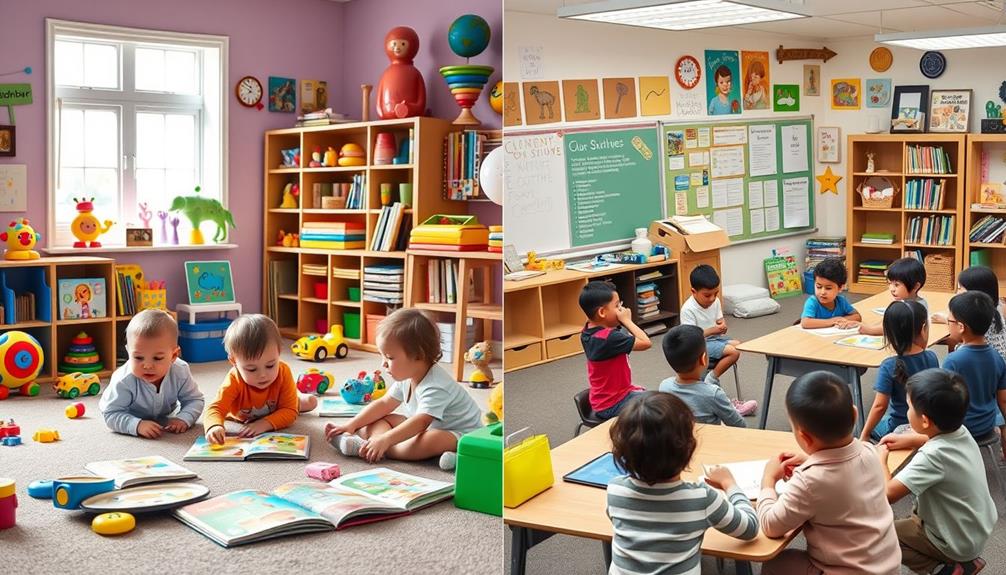When your toddler starts to have a meltdown in public, watch for signs of overwhelm like irritability or sensory overload. Stay calm and acknowledge their feelings with gentle words, then remove them from stressful stimuli if needed. Use distraction with toys or sounds, and keep your tone soothing. Remember to stay patient and composed—you set the tone. For more tips on calming strategies and preventing future outbursts, keep exploring ways to support your child’s emotional needs.
Key Takeaways
- Stay calm and use a gentle voice to acknowledge your child’s feelings during a public meltdown.
- Remove your child from the noisy or overstimulating environment to help them regain composure.
- Offer a favorite comfort item or distraction, like a toy or a simple activity, to redirect their focus.
- Use simple, clear explanations to help your child understand the situation and what’s happening.
- Practice patience, take deep breaths, and model calm behavior to set a positive example during the meltdown.
Recognizing Early Signs of Overwhelm

Recognizing the early signs that your toddler is becoming overwhelmed can help prevent a tantrum before it starts. Pay attention to emotional cues, like sudden fussiness, withdrawal, or irritability, which often signal they’re reaching their limit. You might notice your child covering their ears or squinting in bright environments—signs of sensory overload. They may also become clingy or seek solitude to cope. These cues are your clues that your toddler is overwhelmed by too many stimuli. When you spot these signs early, you can step in to help them regulate their emotions or remove them from the overwhelming situation. Being attentive to these early signals allows you to address your child’s needs before frustration turns into a full-blown meltdown. Recognizing the importance of vetted products like calming tools or sensory-friendly items can also assist in soothing your child effectively. Incorporating emotional regulation techniques can further empower you to manage challenging moments calmly and confidently. Understanding sensory processing differences can also enhance your ability to create a supportive environment tailored to your child’s needs. Additionally, educating yourself about developmental stages can help you anticipate and navigate typical behaviors during this phase.
Immediate Steps to Calm Your Child

When your toddler starts to tantrum in public, taking immediate action can help de-escalate the situation quickly. Show parental empathy by calmly acknowledging their feelings, saying something like, “I see you’re upset.” This helps your child feel understood and supported. Scan the environment for cues that might be contributing to their meltdown, such as loud noises or crowded spaces, and gently guide them to a quieter area if possible. Keep your tone calm and steady, avoiding frustration or anger, which can escalate the tantrum. Offer comfort through gentle touch or a soothing voice. Remember, your calm presence reassures your child, helping them regain control and feel safe amidst the chaos. Quick, empathetic responses are key to calming your child on the spot.
Using Distraction and Redirection Effectively

Once you’ve acknowledged your child’s feelings and created a calmer environment, shifting their focus through distraction and redirection can quickly change the mood. Engage them with creative activities that captivate their attention and promote sensory exploration. You might offer a colorful toy, a playful game, or a simple craft project. Use sensory activities like feeling different textures, listening to musical sounds, or watching bubbles float by to stimulate their senses. Consider these ideas:
Distract and engage your child with sensory activities and playful objects to quickly shift their mood.
- Showing a favorite stuffed animal or toy
- Playing a catchy song and dancing together
- Introducing a new, intriguing object
- Guiding them to observe nature or surroundings
- Making funny faces or sounds to elicit smiles
Incorporating elements of natural materials can also enhance sensory engagement and make the distraction more effective. Utilizing color accuracy in your environment can also make the visual stimuli more appealing and engaging for your child. Being aware of ethical hacking concepts like continuous monitoring can help you understand how to anticipate and manage ongoing challenges. Recognizing the importance of alimony laws and other legal considerations can also inform your approach to navigating difficult situations. These strategies help redirect their energy positively, making it easier to manage tantrums while fostering creative engagement.
Maintaining Your Composure During a Meltdown

Staying calm during your child’s meltdown can be challenging, but your composed response sets a powerful example that helps de-escalate the situation. Practicing parenting patience and emotional regulation allows you to maintain your composure even when emotions run high. Take deep breaths, speak softly, and avoid reacting with frustration or anger. Remember, your calmness shows your child how to handle their feelings constructively. Focus on staying present and grounded, rather than getting caught up in the chaos. This emotional regulation not only helps you manage the moment but also teaches your child valuable coping skills. Additionally, being aware of potential pitfalls in adopting new payment technologies can help you stay focused and avoid unnecessary stress during challenging moments. Understanding the horsepower of electric dirt bikes can remind you that maintaining control during a meltdown is akin to managing a powerful but manageable force, creating a sense of safety and stability that can reduce the intensity of the meltdown and bring you both back to a calmer state. Recognizing child development stages can provide insight into why tantrums occur and help you respond more effectively. Being familiar with environmental considerations in camping can also help you stay grounded and adaptable when unforeseen challenges arise. Incorporating emotional regulation techniques into your routine can further strengthen your ability to stay composed in difficult situations.
Preventative Measures for Future Outbursts

To reduce the likelihood of future tantrums, it’s essential to identify and address the triggers that set your child off. Effective behavior management starts with understanding their cues and avoiding known stressors. Use clear communication techniques, like simple language and consistent responses, to help your child feel secure. You might notice your toddler becoming overwhelmed by:
Identify your child’s triggers and use clear, consistent communication to prevent tantrums.
- Hunger or fatigue, leading to crankiness
- Changes in routine or unfamiliar environments
- Overstimulation from loud noises or crowds
- Frustration from limited choices
- Unmet needs or desires
- Automation technologies can also be used to monitor and predict potential stressors, allowing for proactive interventions to prevent meltdowns. Recognizing emotional cues early can help you intervene before a full-blown tantrum occurs, especially since understanding behavioral triggers is key to managing future episodes. Additionally, incorporating AI-powered monitoring may provide real-time insights into your child’s stress levels, enabling even more effective preventative measures.
Frequently Asked Questions
How Can I Prepare My Child for New or Stressful Situations?
When preparing children for new or stressful situations, you can help them develop stress management skills by talking about what to expect. Explain the upcoming experience simply and positively, and encourage questions. Practice coping strategies like deep breathing or counting to ten beforehand. This way, you’re actively building their confidence and resilience, making stressful moments easier to handle and reducing the chances of tantrums or meltdowns in public.
What Are Long-Term Strategies to Reduce Public Tantrums?
You’re hitting the nail on the head with long-term strategies. To reduce public tantrums, stay consistent with routines, so your child knows what to expect. Practice emotional coaching regularly, helping them name and manage feelings. This approach builds emotional resilience over time. Remember, patience is key—think of it as planting seeds now for smoother days ahead. Over time, your child learns better self-control, making public outings less stressful for everyone.
How Do I Handle Judgment or Negative Comments From Others?
When faced with public judgment or negative feedback, stay calm and confident. Remind yourself that your child’s behavior doesn’t define your parenting. Respond politely if needed, or ignore unnecessary comments. Focus on your child’s well-being rather than others’ opinions. Remember, most people understand that tantrums are normal. Your patience and composure set a positive example, helping you handle negative feedback gracefully and maintain your peace in challenging moments.
When Should I Seek Professional Help for Ongoing Tantrum Issues?
Did you know that nearly 10% of young children experience behavioral challenges that may require professional help? If your child’s tantrums persist beyond typical developmental milestones or markedly disrupt daily life, it’s time to seek behavioral assessments. You should consider professional support when tantrums become intense, frequent, or unmanageable, despite your calm strategies. Addressing these concerns early can promote healthy development and help you manage challenging moments more effectively.
Are There Specific Toys or Comfort Items That Help During Meltdowns?
You can help during meltdowns by offering comfort objects or favorite toys that your child finds soothing. These items provide familiarity and security, helping to calm their emotions. Keep a small comfort object or favorite toy handy, especially in public settings, so your child has a familiar thing to hold onto when they feel overwhelmed. Using these familiar items can make a significant difference in reducing tantrum intensity and helping your child regain composure.
Conclusion
Remember, staying calm during your child’s meltdown is key—you’re the steady hand guiding them through stormy seas. By recognizing early signs, using distraction, and keeping your composure, you can turn a challenging moment into a teachable one. Think of each tantrum as a passing cloud—it’ll move on with patience and love. With consistent effort, you’ll help your toddler learn better ways to express themselves, making future outings smoother and more enjoyable for both of you.










